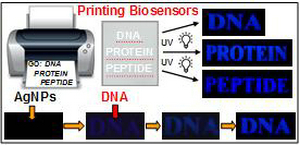Paper-based visualization biosensors built up of nanomaterials have many outstanding advantages such as low cost and facile operation, however, they are rather difficult to obtain due to the loss of optical activeness, decrease of sensitivity and difficulty of preparation.
ZHANG Zongpin’s group in the Institute of Intelligent Machines, Chinese Academy of Sciences has developed a novel method for preparing paper-based visualization biosensors by the employments of photoluminescent grapheme oxide ink and common ink-jet printer, which is a versatile sensing platform for the ultrasensitive detections of peptides, proteins and DNA. The result has been published in Angew. Chem. Int. Ed. (DOI: 10.1002/anie.201201389).
Researchers synthesized highly efficient photoluminescent graphene oxide through the grafting reaction with alkylamines. The fluorescence was strongly quenched by the silver nanoparticles through resonance energy transfer or charge-transfer process, and was immediately recovered through the disassociation of silver nanoparticles from graphene oxide nanosheets due to the addition of the analyte.
The mechanism of fluorescence turn-on was further established on microporous membrane through printing the photoluminescent graphene oxide by common ink-jet printer. The paper-based sensors have been used to untrasensitively detect peptide, protein and DNA with limits of detection at 1 nM, 10 pM and 1 nM, respectively.
